 | |
| Manufacturer | Suzuki |
|---|---|
| Production | 1968 to present |
| Predecessor | HopeStar ON360 |
| Class |
Mini SUV kei car |
| Body style(s) |
2-door Sport utility vehicle 2-door convertible |
| Related |
Suzuki Escudo Maruti Gypsy |
The Suzuki Jimny is a successful line of SUVs from Suzuki. The line started in 1968 and is still running.
History[]
The history of Suzuki four wheel drive cars goes back to 1968. Suzuki bought former Japanese automaker Hope Motor Company which had produced fifteen small off-road vehicles called the HopeStar ON360. Then in 1970, they produced the first "real" Suzuki 4x4. It was called the LJ10, and it had an air cooled, 359 cc, two-stroke, in-line two-cylinder engine. 1972 saw the introduction of the LJ20. The cooling was changed from air cooling to water cooling due to newly enacted emission regulations, and gained 3 hp. In 1975, Suzuki complemented the LJ20 with the LJ50, which had a larger 539 cc, two-stroke, in-line three-cylinder engine and bigger differentials. This was originally targeted at the Australian market, but more exports soon followed.[1]
The Jimny8/LJ80 was an updated version of the LJ50 with an 800 cc, four-stroke, in-line four-cylinder engine, followed by the Jimny 1000/SJ410 and Jimny 1300/SJ413. An updated version of the SJ413 became known as the Samurai and was the first Suzuki officially marketed in the US. The series from SJ410 to SJ413 was known as the Sierra in Australia, and remained the Jimny in some markets.
The new Jimny was released in 1998, and now bears the same name in all markets. The 1998 release used the G13BB EFI engine, replaced by the M13AA EFI engine in 2001 and the M13AA VVT engine in 2005, in conjunction with a minor interior redesign.
HopeStar ON360[]
The vehicle was originally developed by the Hope Motor Company of Japan in 1967 and sold as the HopeStar ON360 from April 1968. It used a Mitsubishi 359 cc (21.9 cu in) air-cooled 2-stroke ME24 engine which produced just 21 PS (15.4 kW). Rear axle was from the Mitsubishi Colt 1000 and wheels from the Mitsubishi Jeep. It was a very basic two-seater vehicle with no doors, but a sturdy four wheel drive system allowed it to go anywhere. Top speed was 70 km/h (43 mph), 30 km/h in 4WD mode. Tiny Hope was unable to sell many of these vehicles (as few as fifteen, although 100 ME24 engines were purchased[2][3]) and sold the design to Suzuki in 1968, after Mitsubishi having declined to take over production.
First generation[]
 Suzuki LJ10 Jimny | |
| Manufacturer | Suzuki |
|---|---|
| Production | 1970–1981 |
| Predecessor | HopeStar ON360 |
| Class | Compact SUV |
| Engine(s) |
359 cc (0.4 l) FB/L50 I2 539 cc (0.5 l) LJ50 I3 797 cc (0.8 l) F8A I4 |
| Transmission(s) | 4-speed manual |
The compact offroader Suzuki Jimny was Suzuki's first global success, lending it name recognition and a foothold in markets everywhere. The Jimny slotted into a hitherto unfilled gap in the market
LJ10[]
Suzuki's first move on acquiring the rights to the ON360 was rebodying it and replacing the Mitsubishi engine with an air-cooled 359 cc (21.9 cu in) Suzuki "FB" two-cylinder two-stroke which produced 25 hp (19 kW). Since the new unit remained smaller than 360 cc, and Suzuki placed the spare tire inside the truck (making it a three-seater) to keep it under 3 meters in overall length, it was classified as a kei car, conferring certain tax privileges and other benefits. When it was introduced in 1970 it was the first four-wheel drive kei car to enter series production. The LJ10 Jimnys had sixteen inch wheels, weighed just 590 kg (1,301 lb), and had a top speed of a mere 75 km/h (47 mph). The engine was quickly uprated to a 27 hp version, but claimed top speed remained unchanged.[4]
LJ20[]
The LJ was updated in May 1972 as the LJ20. The grille bars were changed from horizontal to vertical for the LJ20. The engine was swapped out for a water-cooled unit (the L50), and its 28 hp (21 kW) enabled the LJ to reach 80 km/h (50 mph).[5] A special version with the spare tire mounted behind the passenger seat allowed for two small rear seats, facing each other. The introduction of left hand drive was a major switch and signalled Suzuki's worldwide ambitions for the truck. The Hard Top (Van) was also introduced when the LJ20 arrived, equipped with smaller, 15 inch wheels.[4] Suzuki themselves did not export them to America, a US company called IEC (International Equipment Co.) imported them. Export Jimnys had the spare tire mounted on the outside, as there was no Kei regulations demanding the car be kept shorter than three metres.
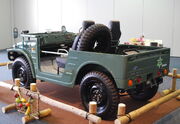
Suzuki Jimny LJ20 (1973), note spare tire placement
Towards the end of LJ20 production, a cleaner 26 hp (19 kW) engine was introduced, a result of ever more stringent emissions regulations. Top speed was reported as 93 km/h (58 mph), payload was 250 kg/550 lb (200 kg/440 lb for the Van version).[6]
SJ10[]
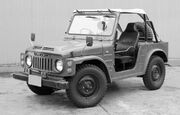
Suzuki Jimny 55 (SJ10)
The LJ50 engine (Japanese: Suzuki LJ50) was first introduced in September 1975 for export only, with 33 hp (25 kW). For the home market, it first appeared in June 1976 as the Jimny 55 and reflected the changing kei car rules and stricter emissions standards. The 539 cc (32.9 cu in) 3-cylinder engine remained a 2-stroke; while power was down to 26 hp (19 kW) more low-end torque was on offer. The 635 kg (1,400 lb) vehicle could now hit 60 mph (97 km/h), and the spare tire was relocated outside the rear door, allowing for a fourth seat. The SJ10 Jimny used the "LJ50" name in most export markets.
In Australia the LJ50S and LJ50V (van) were available as a softtop with soft doors and rear mounted spare wheel or hardtop with full metal doors and external spare wheel through distributor M.W.-Suzuki (Melbourne) with 33 hp and 5.85 kg-m (42 lb-ft) of torque. As of May 1976, the rare LJ51P long wheelbase pickup became available for some export markets. The home market Jimny 550 received a facelift in 1977, introducing rear wheel arch metal flares and a bigger bonnet with cooling slots above the radiator, while the export model LJ50s were instead replaced by the LJ80 (same external modifications but with the new four stroke four cylinder 800 cc engine fitted)
SJ20[]
The final iteration of the original Jimny design was the 1977 Jimny 8, called LJ80 in certain export markets. While the SJ10 remained in production for the domestic Kei category, the new 1700 lb (770 kg) SJ20 boasted a 797 cc (48 in³) 4-stroke SOHC four-cylinder F8A engine capable of around 41 hp (31 kW). The additional power and torque of this engine allowed the differential and gearing to be raised for better cruising and offroad performance, and the track was widened by 4 in (100 mm).
The interior was also improved, with new seats and steering wheel. Metal doors were available for the first time in 1979, and a pickup truck model (LJ81) was available by April of that year as well. The pickup, called "Stockman" in Australia, sat on a 2200 mm wheelbase (up by 270 mm) and was now 3,620 mm (143 in) long, compared to the 3185 mm LJ80. The Jimny 8/LJ80 was retired in late 1981 with the introduction of the second generation Jimny.
Second generation[]
 Suzuki Jimny (USA-spec Samurai) | |
| Manufacturer | Suzuki |
|---|---|
| Also called |
Suzuki Caribbean Suzuki Katana Suzuki Potohar Suzuki SJ410 Suzuki Samurai Suzuki Santana Suzuki Sierra Holden Drover Maruti Gypsy |
| Production | 1981–1998 |
| Assembly |
Hamamatsu, Japan Linares, Jaén, Spain Bangkok, Thailand Gurgaon, India |
| Successor |
Suzuki Jimny JA12/22, JB32 Suzuki Sidekick (Canada) Suzuki X-90 (United States) |
| Class | Mini SUV |
| Body style(s) |
2-door SUV 2-door convertible |
| Layout | Front engine, rear-wheel drive / four-wheel drive |
| Engine(s) |
539 cc (0.5 l) LJ50 2-stroke I3 547 cc (0.5 l) F5A I3 657 cc (0.7 l) F6A I3 658 cc (0.7 l) K6A I3 970 cc (1.0 l) F10A I4 1,298 cc (1.3 l) G13BA/G13BB I4 1,324 cc (1.3 l) G13A I4 1,905 cc (1.9 l) XUD 9 Peugeot turbodiesel I4 |
| Transmission(s) | 5-speed manual |
| Wheelbase |
2,030 mm (80 in) LWB: 2,375 mm (94 in) |
| Length | 3,195–4,010 mm (126–158 in) |
| Width | 1,395–1,535 mm (55–60 in) |
| Height | 1,670–1,840 mm (66–72 in) |
The Suzuki SJ30 began production in May 1981 in Hamamatsu, Japan. In Japan, it was sold as the Suzuki Jimny and was a kei car, produced with both 550 cc and 660 cc 3-cylinder engines. The SJ-Series received a bigger engine and was lengthened and widened for export purposes, where it was sold with a multitude of names: Suzuki SJ410/413, Suzuki Samurai, Suzuki Sierra, Suzuki Potohar (Pakistan), Suzuki Caribbean (Thailand), Suzuki Katana (Indonesia), Chevrolet Samurai, Holden Drover (Australia) and Maruti Gypsy (India).
SJ30[]
The SJ30 Jimny 550 was mainly for Japanese domestic market consumption where it suited the Kei car category. Still powered by the LJ50 engine also used in its predecessor, the Jimny 550 was by a sizable margin the last two-stroke engine built in Japan. Production ended with the withdrawal of type approval in November 1987 in favor of its F5A engined brother, the JA71. The two-stroke had been favored by Japanese off-roaders (and by Suzuki) due to its superior torque.
SJ40[]

Suzuki SJ410 - Note the Jeep badge added by the owner on the "B" pillar
The SJ40 Jimny 1000 was introduced in 1982 as an updated version of the LJ80. It used the F10A, a larger 1-litre version of the LJ's 0.8 liter 4-cylinder engine. This engine produced 45 hp (34 kW) and it had a top speed of 68 mph (109 km/h).
A 4-speed manual transmission was standard, as were non-power assisted drum brakes front and rear. The SJ410 came as a half-door convertible, pickup truck, 2-door hardtop, raised-roof hardtop, and no-glass hardtop. The SJ410 was also produced in Spain by Santana Motors in their Linares, Jaén factory as of March 1985 and sold as a domestic vehicle in Europe due to its over 60% native parts content.[7] Some later models of the SJ410 would switch to disk brakes in the front depending on the factory they were made at. In March 1990, Santana-built versions received the same chassis developments which turned the SJ413 into the Samurai; this version was sold as Samurai 1.0 where it was offered ("Samurai Mil" in Spain).[8]
Maruti Gypsy[]
- Main article: Maruti Gypsy
Indian built SJ-410, only available in a LWB version. The Gypsy remains in production for the South Asian market, as does the Pakistani "Suzuki Potohar". The version still produced in India by Maruti Suzuki is the Maruti Gypsy King, using the 16V 1.3 liter 80 hp (60 kW) engine.
SJ413/Samurai[]
JA51 Jimny 1300
In 1984, the SJ was revamped with the launch of the SJ413 (internal model code JA51). The SJ413 included a larger 1.3 liter 4-cylinder engine, 5-speed manual transmission and power brakes all around. The body and interior were also redesigned, with a new dashboard, seats, and grille. The SJ410 remained in production for various other markets with the old specifications.
North American market[]
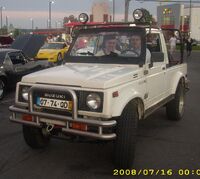 Suzuki Samurai (North America-spec) |
The SJ-Series was introduced to the United States (Puerto Rico (SJ-410) and Canada earlier) in 1985 for the 1986 model year. It was priced at just $6200 and 47,000 were sold in its first year. The Samurai had a 1.3 liter, 63 hp (47 kW), 4-cylinder engine and was available as a convertible or a hardtop. The Suzuki Samurai became intensely popular within the serious 4WD community for its good off road performance and reliability compared to other 4WDs of the time. This is due to the fact that while very compact and light, it is a real 4WD vehicle equipped with a transfer case switchable 4WD and low range. Its lightness makes it a very nimble off roader less prone to sinking in softer ground than heavier ones. It is also considered a great beginner off-roader due to its simple design and ease of engine and suspension modifications.
The 1988.5 model Samurai was re-tuned for better on-road use in the United States. This revision included softer suspension settings and a larger anti-sway bar to reduce body roll. A lower 5th gear (.865:1 vs the earlier .795:1) increased engine rpm and power on the highway, and improved dashboard and seats made the Samurai more comfortable.
A new 1.3 4-cylinder engine with throttle-body fuel injection was introduced with 66 hp (49 kW) in September 1991.[8] The Samurai was withdrawn in Canada in 1989 as the Suzuki Sidekick replaced it; however, sales in the United States market continued until 1995. Low sales prompted the withdrawal of the Samurai from the United States
Consumers Union lawsuit[]
An unfavorable 1988 review of the Samurai in Consumer Reports for being unsafe and prone to rollovers led to a controversial lawsuit and an early withdrawal of the Samurai from the US market.
Other Markets[]
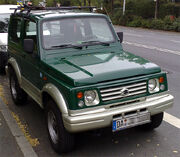
Late Euro-spec Samurai
The SJ413/Samurai had a longer history in the rest of the world. Australian built JA51s were sold as either Suzuki Sierra or Holden Drover, while those built in Thailand are called Suzuki Caribbean. The Caribbean has also been available as the "Caribbean Sporty", a unique LWB double cab pickup.
Due to various trade obstacles for Japanese cars, Spanish Santana Motors (in addition to the SJ410) began local production of the SJ413 in 1986.[7] The Santana built SJs had softer springs for an improved on-road ride, color coordinated interiors with cloth seats and carpeted floors, all to broaden appeal to those who did not intend to off-road the vehicle.[9] In 1989 it received some optical as well as chassis updates and received the "Samurai" nameplate. Santana built Samurais did not benefit from the updated coil sprung chassis introduced in 1998, instead receiving a facelift (new grille, more rounded bumpers) specific to European and neighboring markets. Santana also added a version which used PSA's XUD 9 1.9-litre turbodiesel, producing 63 hp. Top speed was 130 km/h.[10] Spanish Samurai production ended in 2003.
The Samurai was sold in Colombia and Venezuela as Chevrolet Samurai, assembled in Bogotá, Colombia by General Motors Colmotores. In other South American markets, (Argentina, Bolivia, Brazil, Chile, Peru, Paraguay and Uruguay), it was sold as the Suzuki Samurai. Long wheelbase models were not offered in the Mercosur.
High altitude world record[]
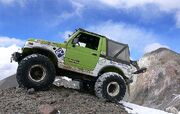
The modified vehicle used in the expedition.
On April 21, 2007, the Chilean duo of Gonzalo Bravo and Eduardo Canales drove their modified Suzuki Samurai (SJ413) up Ojos del Salado, past the previous record set by a Jeep at 6,646 meters (21,804 ft), setting a new record for the highest altitude attained by a four-wheeled vehicle at 6,688 meters (21,942 ft).
The Samurai in question benefitted from wheel, tire, and suspension changes, and a supercharged G16A 4-cylinder underhood. It was the third attempt for the two man team, after encountering weather difficulties on the first attempt and an engine fire in the second. The previous record holder's team led by Matthias Jeschke driving a Jeep Wrangler, left a sign reading "Jeep Parking Only: All others don't make it up here anyway". The Chilean team found the sign, blown down by strong winds, and brought it back to civilization as a souvenir.
This record was duly certified by the Guinness World Record in July 2007.
Kei history[]
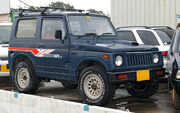
Suzuki Jimny JA71 series
In January 1986 the JA71, a four-stroke, turbocharged and fuel-injected (F5A) 543 cc three-cylinder engine was introduced to complement the two-stroke SJ30. It used the upgraded interior from the Jimny 1300, which was simultaneously introduced to the SJ30. Power was 42 PS (31 kW), although this was increased to 52 PS (38 kW) in a November 1987 facelift by adding an intercooler. A non-intercooled, 38 PS (28 kW) engine was offered in the lowest spec Van version. At the same time, a glassed high-roof version ("Panoramic Roof") was added.[11]
660 cc Era[]
The JA71 was replaced in March 1990 by the new JA11 as new Kei category regulations took effect. Now with 657 cc on offer, the otherwise similar F6A engine only came with an intercooler and 55 PS (40 kW). A utilitarian van (HA), as well as more luxurious Hardtop, Convertible, and Panoramic Roof (HC, CC, EC) versions were on offer.[12] The suspension was also upgraded, while a longer front bumper meant that the foglights could be mounted in front of the grille rather than in it. In June 1991, power was increased to 58 PS (43 kW) and a year later power steering and automatic transmission became available for the first time. Top speed of this version was 120 km/h (75 mph).[8] In February 1995 power increased to 64 PS (47 kW), but production of the JA11 ended only nine months later with the introduction of the coil sprung JA12/22.
Coilsprung version[]
| Manufacturer | Suzuki |
|---|---|
| Production | 1995–1998 |
| Assembly |
Linares, Jaén, Spain Hamamatsu, Japan Bogotá, Colombia |
| Predecessor | Suzuki SJ series |
| Class | Mini SUV |
| Body style(s) |
2-door SUV 2-door convertible |
| Layout | Front engine, rear-wheel drive / four-wheel drive |
| Engine(s) |
657 cc (0.7 l) F6A I3 658 cc (0.7 l) K6A I3 1,298 cc (1.3 l) G13BA/G13BB I4 |
| Transmission(s) |
5-speed manual 3-speed automatic |
| Wheelbase | 2,030 mm (80 in) |
| Length | 3,295–3,430 mm (129.7–135.0 in)[13] |
| Width | 1,395–1,550 mm (54.9–61.0 in) |
| Height | 1,670–1,825 mm (66–72 in) |
The Samurai continued for sale outside the United States (where the newer version is referred to as the 'Coily'), with a substantial update in November 1995. This included a coil spring suspension, though the live axles were retained. The rest of the truck was redesigned as well, with new seats, dashboard, steering wheel, and doors joining a more "macho" exterior.
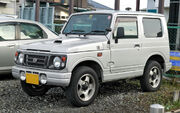
Suzuki Jimny series JA12W
The JA12 used the 657 cc F6A from the JA11 three-cylinder while the JA22 received the newly developed and more powerful K6A - although to abide by the Kei Jidosha regulations claimed output was 64 hp for both engines. The JB32 received the larger 85 hp, 1.3 litre G13BB 16 valve engine was slightly longer and wider due to bigger bumpers and fenders. This, although usually equipped with the eight-valve, 70 hp G13BA engine, was the model seen in most export markets.
Not all models were updated however, with the original narrow SJ410 still in production in some countries. While the third generation Jimny replaced the Jimny/Samurai in most markets after 1998, it still remains in production in India.
Third generation[]
 Suzuki Jimny 660 JB23 | |
| Manufacturer | Suzuki |
|---|---|
| Also called |
Suzuki Jimny Wide Suzuki Jimny Sierra Chevrolet Jimny Mazda AZ-Offroad |
| Production | Jan 1998–present |
| Assembly |
Hamamatsu, Japan Bogotá, Colombia Linares, Jaén, Spain |
| Class | Mini SUV |
| Body style(s) |
2-door SUV 2-door convertible |
| Layout | Front engine, rear-wheel drive / four-wheel drive |
| Engine(s) |
JB23: 658 cc (0.7 l) K6A I3 JB33: 1,298 cc (1.3 l) G13BB I4 JB43: 1,328 cc (1.3 l) M13A I4 JB53: 1,461 cc (1.5 l) Renault K9K turbodiesel I4 |
| Transmission(s) |
5-speed manual 4-speed automatic |
| Wheelbase | 2,030 mm (80 in) |
| Length | 3,295–3,645 mm (129.7–143.5 in) |
| Width | 1,395–1,600 mm (54.9–63.0 in) |
| Height | 1,655–1,715 mm (65.2–67.5 in) |
At the 1997 Tokyo Motor Show, Suzuki presented the all-new Jimny with a much more modern design.[14] A ladder type chassis and a dual ratio transfer case was retained, unlike many competing compact 4WDs which lack a low range, and are strictly in the crossover category. Two bodystyles are available in export markets: a standard hard top and the Canvas Top, introduced at the Barcelona Motor Show in May 1999 and built only by Santana in Spain.[7] The Jimny replaced the popular Sierra/Samurai model in most markets (European introduction was in Paris, 1998[15]), though its predecessor remains in limited production in some places. For the domestic market, a 660 cc K6A engined version suited for the Kei Jidosha class answers for most Jimny sales.
The larger 1.3-litre Jimny was originally equipped with the G13BB engine also used in the JB32. The 80 hp G13BB engine was replaced in Japan with the January 2000 introduction of the newly designed VVT 16-valve M-engine, but soldiered on in Spanish-built softtops until 2005.[16] For the diesel loving continental European market, in 2004 the turbodiesel Jimny JB53 was introduced, built by Santana and using a Renault-built DDiS 1,461 cc K9K engine. Power was originally 65 hp but was increased to 86 hp in 2005, the same as in gasoline versions.[14] It remains unavailable in Britain and Ireland.
Jimny features a part time 4WD system. On its dashboard, there are three buttons - 2WD, 4WD and 4WD-L. The 2WD is default when it runs as RWD. When 4WD is pressed, the front wheels are also engaged as drive with high gears. The 4WD-L engages front wheels as well as low ratio gears. Being a part time 4WD, there is no center differential or viscous coupling. The Jimny should not be driven on normal road surface in 4WD mode.
The Jimny's vacuum-locking hubs allow the vehicle to be shifted from 2WD to 4WD while travelling at up to 100 km/h (62 mph). Shifting to low range requires the vehicle to be stopped, but there is no need to exit the vehicle. Newer Jimnys feature electronic push-button selectable four-wheel drive.
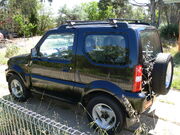
1999 Suzuki Jimny JLX JB33
The Jimny features large windows, giving excellent visibility, apart from a rather serious blind spot caused by the oversized "B" pillar. The large amount of glass also creates a greenhouse effect, and the Jimny comes with air conditioning as a standard feature in some regions.
In Europe, both Hard Top and Canvas Top versions come in JX and JLX specifications. These are fairly standard designations across the Suzuki off road range, with the JLX being the fully-optioned "luxury" version. In the case of the Jimny, the JLX adds roof rails, power steering, power windows, electronically adjustable exterior mirrors, and several interior comfort improvements. Both models are available with a 5 speed manual or 4 speed automatic gearbox. There is also a 2WD option, only available as a 5 speed manual.
As in Japan, Jimnys in Australia have borne the name Jimny Sierra since 2007, largely due to the Sierra name having become synonymous with small, capable off-road vehicles. Since 1999, GM Colmotores have been assembling the 1.3-litre, 79 hp (59 kW) JB33 with the name "Chevrolet Jimny" in Bogotá, Colombia.[17] The Jimny is also available as a grey-import in Singapore
Development history[]
This collapsed table covers the development history of the Jimny in the Japanese domestic market, with notable export variations and developments also noted.
| Jimny development 1970-today | |||||||||||||||||||||||||||||||||||||||||||||||||||||||||||||||||||||||||||||||||||||||||||||||||||||||||||||||||||||||||||||||||||||||||||||||||||||||||||||||||||||||||||||||||||||||||||||||||||||||||||||||||
|---|---|---|---|---|---|---|---|---|---|---|---|---|---|---|---|---|---|---|---|---|---|---|---|---|---|---|---|---|---|---|---|---|---|---|---|---|---|---|---|---|---|---|---|---|---|---|---|---|---|---|---|---|---|---|---|---|---|---|---|---|---|---|---|---|---|---|---|---|---|---|---|---|---|---|---|---|---|---|---|---|---|---|---|---|---|---|---|---|---|---|---|---|---|---|---|---|---|---|---|---|---|---|---|---|---|---|---|---|---|---|---|---|---|---|---|---|---|---|---|---|---|---|---|---|---|---|---|---|---|---|---|---|---|---|---|---|---|---|---|---|---|---|---|---|---|---|---|---|---|---|---|---|---|---|---|---|---|---|---|---|---|---|---|---|---|---|---|---|---|---|---|---|---|---|---|---|---|---|---|---|---|---|---|---|---|---|---|---|---|---|---|---|---|---|---|---|---|---|---|---|---|---|---|---|---|---|---|---|---|
|
| ||||||||||||||||||||||||||||||||||||||||||||||||||||||||||||||||||||||||||||||||||||||||||||||||||||||||||||||||||||||||||||||||||||||||||||||||||||||||||||||||||||||||||||||||||||||||||||||||||||||||||||||||
See also[]
- Suzuki Samurai v Consumers Union -- Suzuki of North America sued CU over its unfavorable review of the rollover-prone Samurai.
References[]
- ↑ "History of Suzuki 4x4: 1975". Suzuki Motor Corporation. Archived from the original on 2010-07-28.
- ↑ (2009) 360cc Light Commercial Truck 1950-1975 (360cc 軽商用貨物自動車 1950-1975). Tokyo: Yaesu Publishing, 34. ISBN 9784861441394.
- ↑ Kazuo Ozeki, Suzuki Story: Small Cars, Big Ambitions. Miki Press: 2007, p. 84. ISBN 978-4-89522-503-8
- ↑ 4.0 4.1 (2007) Car Graphic: Car Archives Vol. 5, '70s Japanese Cars (in Japanese). Tokyo: Nigensha, 145. ISBN 978-4-544-09175-5.
- ↑ (1974) Quattroruote: Tutte le Auto del Mondo 74/75. Milano: Editoriale Domus S.p.A, 846.
- ↑ (1976) World Cars 1976. Bronxville, NY: L'Editrice dell'Automobile LEA/Herald Books, 378–379. ISBN 0-910714-08-8.
- ↑ 7.0 7.1 7.2 (2006) World of Cars 2006·2007. Warsaw, Poland: Media Connection Sp. z o.o., 76—77.
- ↑ 8.0 8.1 8.2 (1992) Quattroruote: Tutte le Auto del Mondo 1992. Milano: Editoriale Domus S.p.A., 1323–1327.
- ↑ (1987) Off Road and 4 Wheel Drive July 1987. Poole, England: Link House Publications.
- ↑ (2002) Katalog der Automobil Revue 2002. Berne, Switzerland: Revue Automobile, 552–553.
- ↑ (2007) Car Graphic: Car Archives Vol. 11, '80s Japanese Cars. Tokyo: Nigensha, xx. ISBN 978-4-544-91018-6.
- ↑ 12.0 12.1 "U's Station On the Net - Short Catalog by Model". Suzuki Motor Corporation. Archived from the original on 2010-06-26.
- ↑ (1996) Auto Katalog 1997. Stuttgart: Motor Presse International, 232–235.
- ↑ 14.0 14.1 (2006) World of Cars 2006·2007. Warsaw, Poland: Media Connection Sp. z o.o., 188–190, 398–399.
- ↑ (2006) World of Cars 2006·2007. Warsaw, Poland: Media Connection Sp. z o.o., 188.
- ↑ (2004) Auto Katalog 2005. Stuttgart: Motor Presse International, 171, 256–257.
- ↑ (2006) World of Cars 2006·2007. Warsaw, Poland: Media Connection Sp. z o.o., 28.
- ↑ "U's Station On the Net - Short Catalog by Model". Suzuki Motor Corporation. Archived from the original on 2010-06-26.
- ↑ Kazuo Ozeki, Suzuki Story: Small Cars, Big Ambitions. Miki Press: 2007, p. 87-88. ISBN 978-4-89522-503-8
- ↑ 20.0 20.1 20.2 Kazuo Ozeki, Suzuki Story: Small Cars, Big Ambitions. Miki Press: 2007, p. 91-92. ISBN 978-4-89522-503-8
- ↑ "U's Station On the Net - Short Catalog by Model". Suzuki Motor Corporation. Archived from the original on 2010-06-26.
- "Suzuki's 4x4 History". Suzuki global site.
- "Suzuki's 4x4 History". Suzuki Japan.
- "Suzuki's 4x4 History". Off-Road.com. Archived from the original on February 17, 2006. Retrieved on March 2, 2006.
- Suzuki Jimny (Japanese Wikipedia)
External links[]
- Jimny Club international section
- UK Jimny page
- Suzuki Samurai hard tops
- Suzuki Rare Models
- World Record for Highest Altitude
- www.suzuki4X4.cl; chilean Suzuki 4WD page
- Samurai Transfer Case Gear Ratio Comparison Chart
- Suzuki Samurai information site
| ||||||||
| Suzuki road vehicle timeline, North America market, 1985–present | |||||||||||||||||||||||||||
|---|---|---|---|---|---|---|---|---|---|---|---|---|---|---|---|---|---|---|---|---|---|---|---|---|---|---|---|
| Type | 1980s | 1990s | 2000s | 2010s | |||||||||||||||||||||||
| 5 | 6 | 7 | 8 | 9 | 0 | 1 | 2 | 3 | 4 | 5 | 6 | 7 | 8 | 9 | 0 | 1 | 2 | 3 | 4 | 5 | 6 | 7 | 8 | 9 | 0 | 1 | |
| Subcompact | Forsa | Swift | Swift | Swift | |||||||||||||||||||||||
| Compact | Esteem | Aerio | SX4 | ||||||||||||||||||||||||
| Forenza/Reno | |||||||||||||||||||||||||||
| Mid-size | Verona | Kizashi | |||||||||||||||||||||||||
| Mini SUV | Jimny / Samurai | X-90 | |||||||||||||||||||||||||
| Sidekick | Vitara | ||||||||||||||||||||||||||
| Compact SUV | Grand Vitara | ||||||||||||||||||||||||||
| Mid-size SUV | XL-7 | ||||||||||||||||||||||||||
| Crossover | XL7 | ||||||||||||||||||||||||||
| Grand Vitara | |||||||||||||||||||||||||||
| Pickup | Equator | ||||||||||||||||||||||||||
| Engines | G · H · M | ||||||||||||||||||||||||||
| This page uses some content from Wikipedia. The original article was at Suzuki Jimny. The list of authors can be seen in the page history. As with Tractor & Construction Plant Wiki, the text of Wikipedia is available under the Creative Commons by Attribution License and/or GNU Free Documentation License. Please check page history for when the original article was copied to Wikia |